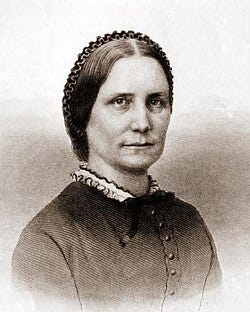Mary Lincoln and the Quaker Community
The Quakers' thwarted plans to buy the Lincoln family a nice house.
Shortly after Lincoln’s second inauguration in early 1865, the Chicago New Convenant, a Universalist newspaper, featured correspondence from Mary Livermore.[1] Livermore was an American journalist, abolitionist, and advocate of women's rights from Boston.
The letter describes her meeting with the Lincolns to invite them to the Chicago Sanitary Fair being held that summer. Livermore also reported that had learned from “a lady Quaker, who occupies a prominent official position under the administration” that the Quakers of Philadelphia “design to purchase for the President a beautiful home in Chicago. Several situations now in market are spoken of, but nothing is yet definitely agreed on—except the purchase, when the selection is made.”
It later came out that the Quakers ended up having to lay low prior to the 1864 election with regard to this plan, at the request of Lincoln and others, because of political considerations, including the possibility of losing Episcopalian support at a critical time.
A few weeks later, while Mary was still in the White House following her husband's assassination, a different Washington correspondent suggested that a project started during Lincoln’s life be carried out as one of “many generous plans which are being suggested for placing the family . . . in an independent position for the rest of their days.” The project he was referring to was that of a wealthy and prominent group of Quakers, led by Commissioner of Agriculture (and Quaker) Isaac Newton, who had wanted to purchase a “handsome residence” for Lincoln to retire to.
The Quakers wanted to give it to show their esteem and appreciation for his understanding of their pacifism and accommodation of it, and also for his cooperation with their efforts on behalf of the Freedmen. Newton, described as a “warm and intimate personal friend” of the Lincolns, tried to feel out where Lincoln might want to live. Newton “gleaned” he wanted to return to Springfield, “but that Mrs. Lincoln had a strong aversion to going back to that city and he should probably yield to her wishes in the matter.” Newton suggested the beautiful Chicago lakefront area, to which Lincoln responded, unhelpfully, “that if there was one place more beautiful than another it was just a that that spot.” He could lie the rest of his life happily there—“if it should be Mrs. Lincoln’s choice.” He then realized Newton was asking a curious number of questions, and, seeing where this was going, “remarked that he had ‘nothing further to say—talk with Mrs. Lincoln.’” The reelection delayed the matter, but when it was decided the Lincolns would visit Chicago to attend the Sanitary Fair, it was arranged that Newton and his associates come along for the purpose of selecting a site for the proposed mansion.” The correspondent not sure what they currently proposed to do, “but have no doubt but that they will give some substantial evidence of their appreciation of their martyred friend.”[2]
On February 13, 1867, shortly after John Hay had returned to America from several years abroad, he spoke to Isaac Newton about the matter: “He told me what I had not known before that the Jay Cooke fund was never given to Mrs. L. but on the scandals of her last days at the White House becoming known was quietly restored to the donors, most of whom were Quakers.” This is the only other reference I’ve found relating to the subject.
[1] Washington Correspondence from Mary Livermore, March 2, 1865, in the Chicago New Covenant, March 11, 1865.
[2] Washington correspondence from “Carl,” Newark Daily Advertiser May 15, 1865.




